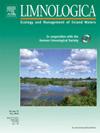莱茵河淡水蜗牛的隐居入侵和种内杂交
IF 2
4区 环境科学与生态学
Q2 LIMNOLOGY
引用次数: 0
摘要
种内隐入侵包括在物种的本地范围内传播和建立非本地遗传谱系。非本地血统的个体可以取代本地个体或与他们杂交。杂交使地理上不同种群的独特特征同质化,从而降低了未来物种多样性的潜力。在欧洲,淡水蜗牛Theodoxus fluviatilis有不同的单倍型,这取决于地理上分离的水系。自2005年以来,在多瑙河和后来在德国的莱茵河中记录到一种单倍型F31的河流绦虫的上游传播,它起源于蓬托-里海地区。在外来单倍型钉螺入侵后不久,我们在上莱茵河和上莱茵河的11个地点采集了301只钉螺。我们使用线粒体标记(COI)测定了这些蜗牛的单倍型:19个个体属于本地单倍型F28(6.3 %),159个个体属于非本地单倍型F31(52.8 %),123个个体属于另一种非本地单倍型“euxinus”(也属于蓬-海起源)(40.9 %)。利用8颗微卫星,我们检测了入侵的非本地单倍型个体是否与本地单倍型F28个体杂交。在301只钉螺中发现12只杂交种(4.0 %)。在调查的11个种群中,有7个发生杂交。我们提供的证据表明,与本地单倍型的杂交早在非本地单倍型入侵后的前1-2代就发生了。这表明,本地的单倍型的T. fluviatilis不太可能在高莱茵河长期存在。本文章由计算机程序翻译,如有差异,请以英文原文为准。
Cryptic invasion and intraspecific hybridisation in the freshwater snail Theodoxus fluviatilis in the river Rhine
Intraspecific cryptic invasion involves the spread and establishment of non-native genetic lineages within the species’ native range. Individuals of non-native lineages can displace native individuals or hybridise with them. Hybridisation homogenises unique characteristics of geographically distinct populations and thus reduces the potential for future species diversity. In Europe, the freshwater snail Theodoxus fluviatilis has different haplotypes depending on the geographically separated water system. Since 2005, an upstream spread of T. fluviatilis with haplotype F31, which originates in the Ponto-Caspian region, has been recorded in the Danube and later in the river Rhine in Germany. Shortly after the invasion of snails with non-native haplotype, we collected 301 individuals of T. fluviatilis from 11 locations in the Upper and High Rhine. We used a mitochondrial marker (COI) for the determination of the snails’ haplotype: 19 individuals belonged to the native haplotype F28 (6.3 %), 159 (52.8 %) to the non-native haplotype F31 and 123 (40.9 %) to another non-native haplotype “euxinus” (also of Ponto-Caspian origin). Using eight microsatellites we examined whether individuals of the invading non-native haplotypes hybridise with individuals of the native haplotype F28. We found 12 hybrids (4.0 %) among the 301 snails examined. Hybrids occurred in 7 out of the 11 populations examined. We provide evidence that hybrids with the native haplotypes occur as early as the first 1–2 generations after the invasion of the non-native haplotypes. This indicates that the native haplotype of T. fluviatilis is unlikely to persist in the High Rhine in the long term.
求助全文
通过发布文献求助,成功后即可免费获取论文全文。
去求助
来源期刊

Limnologica
环境科学-湖沼学
CiteScore
3.70
自引率
5.90%
发文量
64
审稿时长
3 months
期刊介绍:
Limnologica is a primary journal for limnologists, aquatic ecologists, freshwater biologists, restoration ecologists and ecotoxicologists working with freshwater habitats.
 求助内容:
求助内容: 应助结果提醒方式:
应助结果提醒方式:


